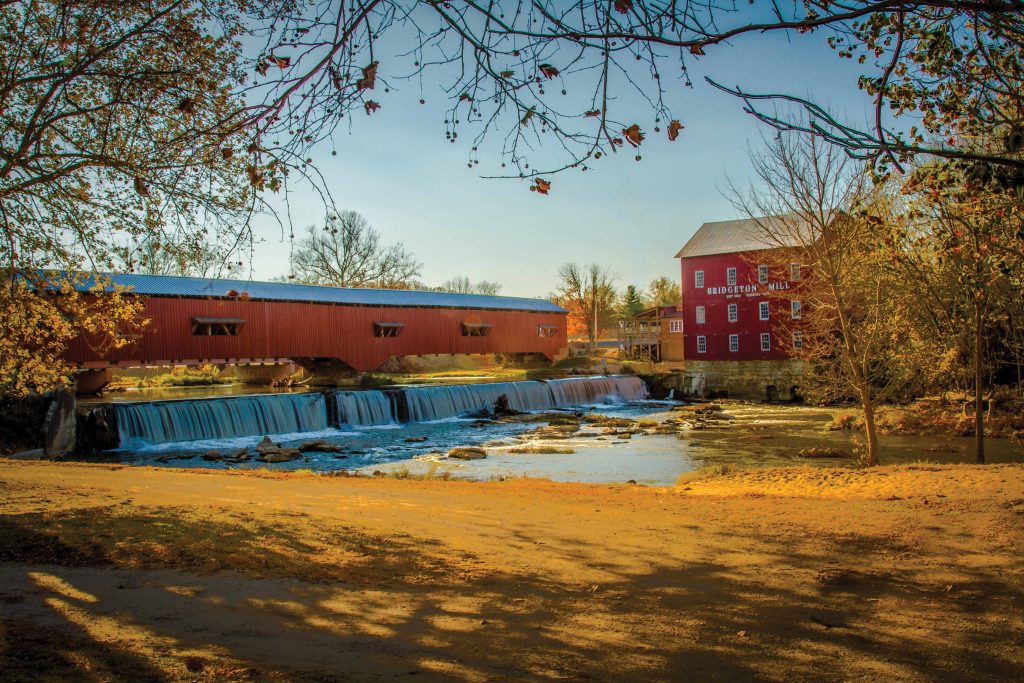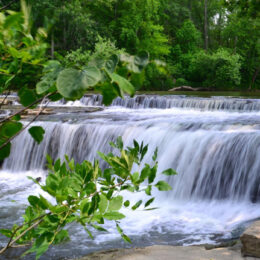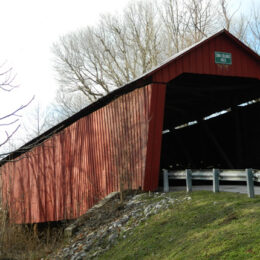
By Richard G. Biever
The west-central Indiana county named after Benjamin Parke, a founding father of Indiana, ends with an “e.” But the county’s cornucopia of well-preserved natural and man-made historical features gives Parke a larger-than-life “park-like” personality.
Parke County is best known for its 31 quaint covered bridges. But it’s also home to two outstanding state parks, a large reservoir and state recreation site, and popular shaded streams. Together, they provide recreational opportunities for individuals, families and groups to explore, shop for crafts and antiques, picnic, hike, camp, bicycle, bird and wildlife watch, ride horseback, fish, boat, canoe, kayak, and, after all that, just float on an inner tube.
Turkey Run State Park was the second state park established in 1916, Indiana’s centennial year. The park takes visitors tripping through time as they hike through deep ravines and sandstone gorges representing some 600 million years of nature’s handiwork and lets them marvel at old growth trees that create a thick canopy overhead. Flowing through the heart of the park, scenic Sugar Creek is a wonderful resource for canoeing and fishing. The park also offers more modern amenities like Turkey Run Inn that’s opened year-round, an Olympic-sized swimming pool, a staffed nature center, and a planetarium.
About five miles up Sugar Creek from Turkey Run is Shades State Park. Though most of the park is in neighboring Montgomery County to the east, Shades straddles the corner of three counties: Montgomery, Parke and Fountain County to the north. Shades, too, offers the chance to explore deep sandstone ravines and stands of aged forests.
On the county’s eastern side is Raccoon State Recreation Area surrounding Cecil M. Harden Lake. The lake was created by the U.S. Army Corps of Engineers for flood control in the late 1950s. As a byproduct, it provides a variety of water and outdoor recreation, wildlife habitat and economic benefits to the area.
The 31 covered bridges are Parke County’s main claim to fame, and Parke County bills itself as the “Covered Bridge Capital.” Between 1820 and 1920, about 500 covered bridges were built in Indiana, fewer than 100 remain. More than half of those that do are in and around Parke County. It’s an area with numerous streams and creeks flowing to the Wabash River which shapes Parke County’s western border with Vermillion County.
The bridges were covered to protect the wooden trusses and deck from rotting. While they came to symbolize rural America and a simple bucolic lifestyle, they became an impediment to agricultural progress as farming machinery grew larger and could not pass through them. Many places opted to remove the bridges as they deteriorated to improve transportation. Parke County saved many of its covered bridges by diverting the roadway around them on new modern bridges built alongside the covered bridge.
Many covered bridges come with the admonition in the arched woodwork entrances overhead: “Cross this bridge at a walk.” Originally it was meant for horse-drawn traffic to pass slowly. Now, the only way, in many cases, to cross them is on foot. And for a county that embraces its natural, rural and small town heritage, it’s good advice folks should heed almost anywhere they go on their walk in the park — in Parke County that is.
RICHARD G. BIEVER is senior editor of Indiana Connection.
County Facts
Founded: 1821
Named for: Benjamin Parke, a member of Indiana’s 1816 Constitutional Convention.
Population: 16,927 (2019)
County seat: Rockville
HOME TO: Thirty-one historic covered bridges. A myriad of recreational opportunities.
Event
Parke County Covered Bridge Festival
Oct. 11-20 | Admission: Free
765-569-5226
https://www.coveredbridges.com
Indiana’s largest festival, held throughout the county, showcases Parke’s 31 historic covered bridges and features authentic arts and crafts, food, two historic mills, and beautiful fall foliage.



